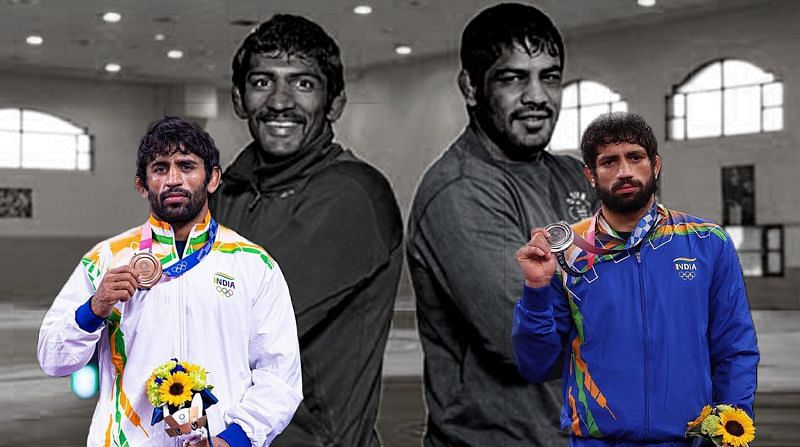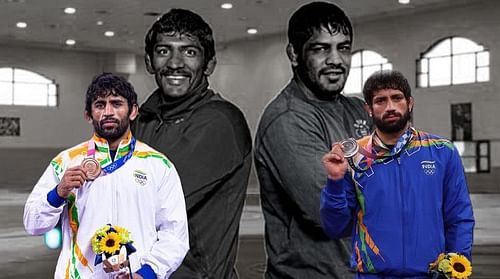
4 Olympic medals and counting - What makes Chhatrasal Akhara the home of Indian wrestling?
When Ravi Dahiya and Bajrang Punia climbed the medal podium in their respective weight categories in Tokyo, there was more to it than what met the common eye. The two wrestlers had finally come out of the shadows of their predecessors – Sushil Kumar and Yogeshwar Dutt -- to write their own destiny. And at the centre of it all was the Chhatrasal Akhara (wrestling academy) that shone brightly in Tokyo.

The most buzzing wrestling hub is nestled in the Chhatrasal Stadium Complex in West Delhi. The Chhatrasal Akhara is to wrestling what Sansarpur in Jalandhar district of Punjab has been to hockey or Azad Maidan in Mumbai to cricket.
As one of the budding wrestlers puts it: “Yaha ki mitti mein kuch alag baat hai. (There is something different here)” The state of the art wrestling coaching center is the place where tradition meets modernity.
Chhatrasal Akhara, started by former Asian Games gold medalist Mahabali Satpal, continues to act as a feeder to Indian wrestling. In the Olympic squad, all the three men’s wrestler – Ravi Dahiya, Bajrang Punia and Deepak Punia – had their roots at the academy.
Ravi Dahiya, who won silver in 57kg category, continues to train there. Bajrang Punia and Deepak Punia, on the other hand, have moved out of Akhara. However, at one point, the trio had been part of the coveted wrestling academy.
Incidentally, out of the six Olympic medalists, four wrestlers have roots at Chhatrasal akhara.
What makes the akhara so special?
Simply put it is the hunger of producing the best wrestlers. This is a big driving force that feeds as a motivation factor for the coaching staff.
"It is satisfactory when one of our students represents India at the Olympics. It is even more soothing when one of them climbs to the podium," Satpal says with teary eyes as two of his students won an Olympic medal.
The basics, though, start in the mud pit, the traditional akhara, before the trainees graduate to the next level to hon their skills on mats. Having extra mats won’t cost India’s most-decorated wrestling gurukul much but there is a purpose and methodology behind grooming wrestlers in a particular way.
“Training in mud helps budding wrestlers attain strength and work on their standing attacks. But movement of mud is tough and therefore they need to use extra force. When they are put on the mat – twice in a week – they suddenly find themselves moving faster and are more agile, courtesy of the hours they put in mud,” says Virender Kumar, a former coach at Chhatrasal akhara.
There is no doubting the sincerity of their beliefs. And perhaps in some ways it the training methodology seems to be working just fine. At the Olympics, Ravi Dahiya was an unstoppable force. His movements were lightning quick and had brilliant reflexes to evade ground attacks.
ALSO READ: Ravi Dahiya Olympic medalist: The destiny written on a 10-acre rented farm
Bajrang Punia, who won bronze in the 65 kg bracket despite a knee injury, benefitted from mud wrestling. His upper body strength amalgamated with unbelievable stamina was key to him finishing at the podium.
“When you train in mud, you know everything will be tough. But that is what makes your foundation. Anything from there will be easy,” Virender added.
The training at Akhara starts at 4:30 am. A customary warm-up – five to ten rounds of the stadium -- is followed up by high intensity training.
After an hour of fitness workouts, begin mat training. The training session can go from anywhere between five to six hours.
“We keep changing the routine to ensure the wrestlers do not get comfortable with it. Flexibility is key in wrestling, and this way we also train them mentally without them knowing it,” Lalit, another coach at Chhatrasal akhara, says.
The weight training sessions are only twice a week.
Following the rigorous workout, wrestlers return to their dormitories to recover and get ready for the evening session.
“We prepare a six-day schedule with Sunday off. The time-table is a combination of training, diet and recovery – the three most important aspects of an athlete’s life,” he revealed.
At the akhara, the management relies on traditional food and nutrition for the trainees. Supplement or synthetic substitutes are not allowed.
“Doodh (Milk), Desi-Ghee (butter oil) and Baadam (almonds) are the basic diet of the wrestlers here. Most of them come from humble backgrounds and are not able to afford the basic diet. For them we have a tie-up with a local milkman who provides us with milk and butter,” Lalit says.
Competitions are a part of the training module of the akhara. After all, what is the point of training without being able to test it?
ALSO READ: Bajrang Punia: The ‘Sher’ of Jhajjar becomes Pride of India
The wrestlers participate in the weekly "dangals." With this they get a feel for the real match situation and financial support with the prize money.
The boys at the academy have their in-house idols. There is no dearth of inspiring tales about how Sushil Kumar and Yogeshwar Dutt became legends. Add Ravi Dahiyas and the Bajrang Punias to that list now. With so many heroes to look up to, every wrestler housed in the akhara knows what it takes to achieve a dream. They have a target set and the Chhatrasal akhada helps them fulfil that with the right amount of guidance.
“Every kid here dreams of becoming the next Sushil or Yogeshwar. Now, there is a new motivation after Ravi returned with silver. It is good motivation factor as all these achievements helps the budding wrestlers remind what they are chasing,” Lalit says.
Chhatarsal Akhara opens the horizons for young prodigies, but getting a chance to train there is an achievement in itself.
“We select wrestlers based on trials. Only those who we think can have a future in wrestling are enrolled. Under Satpal’s guidance and we push the youngsters to their best. But we also keep in mind that rest is important.”
Chhatrasal akhara has stood the test of time. In Tokyo it showed once again, why the akhara is considered the prime wrestling hub of India. With the emergence of new heroes, the next-gen will have new folklore to get inspired with.
“I am glad I came to the Chhatrsal akhara. It gave me everything. Training under Satpal guruji and Sushil pahelwan is something I am thankful for. They are a big reason why I was able to win silver at my debut Olympics,” Ravi Dahiya says.